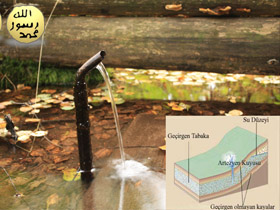
We divided them up into twelve tribes-communities. We revealed to Musa, when his people asked him for water: "Strike the rock with your staff." Twelve fountains flowed out from it, and all the people knew their drinking place. And We shaded them with clouds and sent down manna and quails to them: "Eat of the good things We have provided for you." They did not wrong Us; rather, they wronged themselves. (Qur'an, 7:160)
.jpg)
A closed artesian aquifer is confined by an overlying impermeable body of rock, which prevents any water from filtering down into the aquifer. Instead, water enters the tilted aquifer layer through a recharge area, where the aquifer rock is exposed at higher elevations. The flow in an artesian aquifer resembles water flowing through a J-shaped tube. Water added on the tube’s long side provides enough pressure to drive the water upward on the tube’s shorter side.
The above verse describes how Prophet Musa's (as) people asked him for water and how he provided places where each tribe could drink. Clearly, his people were suffering from a shortage of water. Such shortages still exist, for more than 1 billion people today lack access to clean water, and 2.4 billion still live without improved sanitation. According to projected estimates, by 2025 about 5 billion people will not have access to sufficient amounts of water.190 Every year, some 12 million people die from water scarcity; 3 million of whom are children who die from waterborne diseases.191
Today, 31 countries, comprising 8 percent of the world's population, face chronic freshwater shortages. By 2025, this number is expected to rise to 48 countries.192 According to UN predictions, renewable freshwater will become an even more limited resource by 2025, and the number of 131 million people experiencing water problems will rise to either 817 million (according to low population growth projections) or 1.079 billion (according to high population growth projections).193
Groundwater, the largest source of fresh water on Earth, represents more than 90 percent of the readily available freshwater reserves194 and is therefore of vital importance to meeting the water needs of up to 2 billion people.195 It constitutes the primary source of water for up to 50 percent of the American population, a figure that rises to 95 percent in rural areas.196 Groundwater is also the safest and most reliable source of fresh water. At the same time, this water can be used to produce geothermal energy and save energy by using heat pumps.
When the water sucked up from the soil meets an impermeable underground layer, it collects there and forms a water source. This water is then brought to the surface by the artesian method. Artesian springs are formed by sedimentary rocks that can store underground water.
The fact that artesian wells are drilled in rocky areas runs parallel to the description in the Qur'an. Given that Allah commanded Prophet Musa (as) to strike the rock, Surat al-A`raf 160 may be indicating this method. (Allah knows best.) The verb idrib, translated as "strike," can also mean "to raise, to open." Thus, this verse may be describing a water source being opened by the raising of the rock. As a result, pressurized water may have emerged, as described in the verb inbajasat (to pour out, flow freely, bubble up, flow), just as happens with artesian wells. If sufficient pressure forms, water can continue to flow to the surface without the need for a pump.
Allah is He Who created the heavens and the earth and sends down water from the sky and by it brings forth fruits as provision for you… (Qur’an, 14:32) |
It is particularly striking that current solutions for dealing with water scarcity use underground water resources. In fact, one of the most effective methods of doing so is the artesian well. In other words, we might be copying Prophet Musa's (as) example of striking or lifting the rock without even knowing it. Surat al-A`raf 160 may therefore be a reference to artesian wells, the first of which was opened in 1126 in the French region of Artois. (Allah knows best.)
190. “Climate Change Adding Stress to Scarce Water Resources,” DevNews Media Center, 5 June 2003, http://web.worldbank.org/WBSITE/EXTERNAL/NEWS/0,,contentMDK:20114416~menuPK:
34457~pagePK:34370~piPK:34424~theSite
PK:4607,00.html.![]()
191. “Water—The Essence of Life,” DevNews Media Center, 17 May 2002, http://web.worldbank.org/WBSITE/EXTERNAL/NEWS/0,,contentMDK:20044610~menuPK:34459~
pagePK:64003015~piPK:64003012~
theSitePK:4607,00.html.![]()
192. “Solutions for a Water-Short World,” www.infoforhealth.org/pr/m14edsum.shtml.![]()
193. “Water-Scarce Countries,” excerpted from Sustaining Water: Population and the Future of Renewable Water Supplies,
www.cnie.org/pop/pai/water-14.html.![]()
194. “Creation of an International Groundwater Resources Assessment Centre (INGRACE) –
an information note,” IAH (International Association of Hydrogeologists) News and Information Online, www.iah.org/articles/
mar2000/art002.htm.![]()
195. “Groundwater,” http://ap.world.water-forum3.com/themeWwf/en/themeShow.do?id=36.![]()
196. “The Importance of Groundwater,” http://pasture.ecn.purdue.edu/~agenhtml/agen521/epadir/grndwtr/importance.html.![]()
Adnan Oktar's piece in Truth Seeker:


